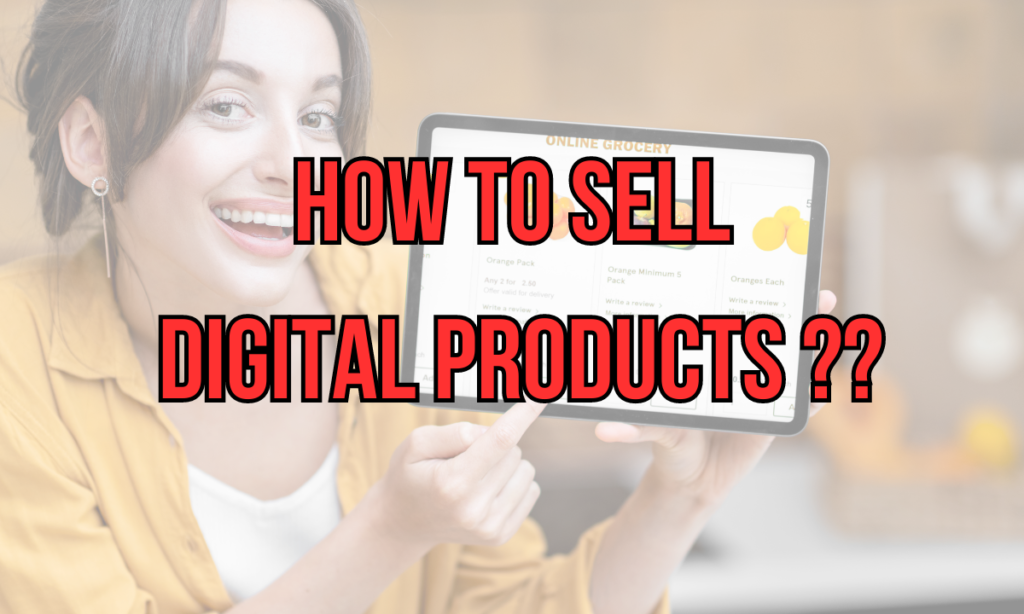
How to Sell Digital Products: A Comprehensive Guide
Selling digital products has become one of the most popular ways to make money online. With low overhead costs, global reach, and the potential for passive income, it’s no wonder that more and more entrepreneurs are diving into the digital marketplace. Whether you’re a creative artist, a tech-savvy developer, or a knowledgeable educator, selling digital products can be a highly profitable venture. In this comprehensive guide, we’ll explore everything you need to know about how to sell digital products, from choosing the right product to building a successful online business.
Understanding Digital Products
Before diving into the how-tos, it’s essential to understand what digital products are. Digital products are intangible goods that exist in digital form and can be delivered electronically. Unlike physical products, digital products don’t require inventory, shipping, or storage. Some common types of digital products include:
- Ebooks: Digital books that can be read on various devices.
- Online Courses: Educational content delivered through videos, slides, and other digital formats.
- Software: Applications, plugins, and tools that can be downloaded and used on computers or mobile devices.
- Digital Art and Graphics: Images, illustrations, and design templates that can be used in various projects.
- Music and Audio Files: Tracks, sound effects, and podcasts that can be downloaded and listened to.
- Membership Sites: Exclusive content and communities that users can access through a subscription.
Benefits of Selling Digital Products
Selling digital products offers numerous benefits, making it an attractive option for many entrepreneurs:
- Low Overhead Costs: Since digital products don’t require physical inventory, shipping, or storage, the initial investment is minimal compared to traditional businesses.
- Global Reach and Scalability: With digital products, you can reach a global audience. Plus, once a product is created, it can be sold an unlimited number of times without additional production costs.
- Passive Income Potential: Once your digital product is created and set up for sale, it can generate income with minimal ongoing effort.
Choosing the Right Digital Product to Sell
Choosing the right digital product is crucial for your success. Here’s how to get started:
- Identifying Your Niche: Start by identifying a niche that aligns with your interests, skills, and expertise. Consider what problems you can solve or what value you can provide to your target audience.
- Market Research and Validation: Conduct market research to determine the demand for your product. Use tools like Google Trends, social media, and online forums to gauge interest and identify potential competitors.
- Evaluating Your Skills and Resources: Consider your skills and available resources when choosing a digital product. For example, if you’re a skilled writer, creating ebooks might be a natural fit. If you’re a graphic designer, selling design templates could be more suitable.
Creating High-Quality Digital Products
Creating a high-quality digital product is essential to stand out in the competitive digital marketplace. Here’s what you need to know:
- Designing and Developing Your Product: Whether you’re creating an ebook, an online course, or software, focus on creating a product that is well-designed, user-friendly, and valuable to your audience.
- Importance of User Experience and Quality: Pay attention to the user experience (UX) and overall quality of your product. Ensure that it’s easy to use, visually appealing, and delivers on its promises.
- Tools and Software for Digital Product Creation: There are many tools available to help you create digital products. For example, you can use Canva for designing graphics, Teachable for creating online courses, or Scrivener for writing ebooks.
Pricing Your Digital Products
Setting the right price for your digital product is crucial to maximizing sales and profitability. Here are some tips:
- Pricing Strategies for Digital Products: Consider using tiered pricing, bundling products, or offering discounts to encourage sales.
- Factors to Consider When Setting Prices: Take into account the perceived value of your product, the prices of competing products, and your target audience’s willingness to pay.
- Psychological Pricing Tactics: Use psychological pricing techniques, such as pricing just below a round number (e.g., $9.99 instead of $10), to make your product appear more affordable.
Building a Sales Funnel for Digital Products
A sales funnel is a marketing strategy that guides potential customers through the buying process. Here’s how to create an effective sales funnel for your digital products:
- What is a Sales Funnel? A sales funnel consists of multiple stages, from attracting visitors to converting them into customers. Each stage requires different marketing tactics to move prospects closer to making a purchase.
- Stages of a Digital Product Sales Funnel: Typically, a digital product sales funnel includes awareness (attracting visitors), consideration (engaging and educating them), and decision (encouraging a purchase).
- How to Optimize Your Sales Funnel: Continuously test and optimize each stage of your funnel to improve conversion rates. Use A/B testing, analyze user behavior, and refine your messaging and offers.
Choosing the Right Platform to Sell Your Digital Products
The platform you choose to sell your digital products can significantly impact your success. Here’s a look at some popular options:
- Overview of Popular Platforms: Some of the most popular platforms for selling digital products include Etsy, Gumroad, Shopify, and Amazon. Each platform has its pros and cons, so it’s essential to choose one that aligns with your business goals.
- Pros and Cons of Each Platform: For example, Etsy is great for selling creative products like digital art, but it may not be ideal for selling software. Shopify offers extensive customization, but it comes with higher costs.
- Setting Up Your Online Store: Once you’ve chosen a platform, set up your online store by creating product listings, setting prices, and integrating payment gateways.
Marketing Strategies for Digital Products
Marketing is key to driving sales and growing your digital product business. Here are some effective strategies:
- Content Marketing: Create valuable content, such as blog posts, videos, and tutorials, to attract and engage your target audience. Content marketing helps build trust and establishes you as an authority in your niche.
- Social Media Marketing: Use social media platforms like Instagram, Facebook, and Twitter to promote your digital products, connect with your audience, and drive traffic to your online store.
- Email Marketing: Build an email list and use it to send newsletters, product updates, and promotional offers. Email marketing is one of the most effective ways to convert leads into customers.
- Paid Advertising: Consider using paid advertising, such as Google Ads or Facebook Ads, to reach a broader audience and drive more sales.
Building an Audience for Your Digital Products
Building a loyal audience is crucial for long-term success. Here are some tips:
- Importance of Audience Building: A loyal audience is more likely to purchase from you repeatedly and recommend your products to others. Focus on building relationships with your audience rather than just selling to them.
- Strategies to Grow Your Audience: Use content marketing, social media, and email marketing to attract and engage your target audience. Offer free value, such as lead magnets or free trials, to encourage sign-ups and build your list.
- Engaging with Your Audience: Regularly interact with your audience through social media, email, and live events. Respond to comments, answer questions, and show appreciation for their support.
Using SEO to Boost Your Digital Product Sales
Search engine optimization (SEO) can help you reach more potential customers and increase sales. Here’s how:
- Basics of SEO for Digital Products: SEO involves optimizing your website and content to rank higher in search engine results. Focus on using relevant keywords, optimizing meta tags, and creating high-quality content.
- On-Page and Off-Page SEO Strategies: On-page SEO includes optimizing your product pages, blog posts, and images. Off-page SEO involves building backlinks and increasing your online presence.
- How to Rank Higher in Search Results: To rank higher in search results, create valuable, keyword-rich content, improve your website’s loading speed, and ensure your site is mobile-friendly.
Handling Payments and Delivery
Efficiently handling payments and delivering your digital products is crucial for a smooth customer experience. Here’s what you need to know:
- Payment Gateway Options: Choose a reliable payment gateway, such as PayPal, Stripe, or Square, to process transactions securely.
- Automating Digital Product Delivery: Use tools and platforms that automatically deliver your digital products to customers upon purchase. This ensures a seamless experience and reduces manual work.
- Ensuring a Smooth Customer Experience: Make sure your checkout process is simple and user-friendly. Offer multiple payment options and provide clear instructions for accessing and using the purchased product.
Protecting Your Digital Products
Protecting your digital products from piracy and unauthorized use is essential. Here’s how:
- Importance of Copyright and Licensing: Registering your digital products with a copyright ensures legal protection. Clearly state the licensing terms for your products to inform customers of their rights and restrictions.
- How to Protect Your Digital Products from Piracy: Use digital rights management (DRM) tools, watermark your digital art, and set up download restrictions to minimize the risk of piracy.
- Tools for Safeguarding Your Products: Consider using tools like CopyScape to monitor the web for unauthorized use of your content. Additionally, platforms like Gumroad offer built-in protections for digital products.
Analyzing and Optimizing Your Sales Performance
Regularly analyzing your sales performance is key to continuous improvement. Here’s how:
- Tracking Sales and Performance Metrics: Use analytics tools to track key metrics, such as sales volume, conversion rates, and customer acquisition costs. This data can help you understand what’s working and where to improve.
- How to Use Analytics to Improve Sales: Analyze your data to identify trends and patterns. For example, if you notice a drop in sales, investigate the cause and adjust your strategy accordingly.
- A/B Testing and Continuous Optimization: A/B testing involves comparing two versions of a webpage or marketing campaign to see which performs better. Continuously test and optimize your sales pages, emails, and ads to improve results.
Conclusion
Selling digital products is a lucrative and scalable business model with endless possibilities. By choosing the right product, creating high-quality content, and implementing effective marketing strategies, you can build a successful online business. Remember, success doesn’t happen overnight, but with persistence and continuous learning, you’ll be well on your way to achieving your goals.
FAQs
What are the most profitable digital products to sell?
The most profitable digital products often include online courses, software, ebooks, and digital art. However, the profitability depends on your niche, audience, and the value you offer.How do I choose the right platform for selling my digital products?
Consider factors such as your target audience, the type of product you’re selling, and your budget. Platforms like Shopify offer extensive customization, while Etsy is ideal for creative products.Can I sell digital products without a website?
Yes, you can sell digital products without a website using platforms like Gumroad, Etsy, or Amazon. However, having a website gives you more control over branding and customer experience.How do I handle customer support for digital products?
Provide clear instructions, FAQs, and contact options on your sales page. Consider using a ticketing system or chatbot to manage customer inquiries efficiently.What are some common mistakes to avoid when selling digital products?
Common mistakes include underpricing your products, neglecting marketing, and not protecting your products from piracy. Ensure you’re continually optimizing your strategy and learning from feedback.
-
Sale!

500+ CANVA TEMPLATES PLANNER BUNDLE
Add to cart$ 19,99Original price was: $ 19,99.$ 5,00Current price is: $ 5,00. -
Sale!

15 Millions Digital Products
Add to cart$ 19,99Original price was: $ 19,99.$ 10,00Current price is: $ 10,00. -
Sale!

400k Digital Products Library
Add to cart$ 19,99Original price was: $ 19,99.$ 5,00Current price is: $ 5,00. -
Sale!

15 MILLION DIGITAL PRODUCTS PLR Bundle
Add to cart$ 19,99Original price was: $ 19,99.$ 5,00Current price is: $ 5,00. -
Sale!

20k Canva Templates
Add to cart$ 10,00Original price was: $ 10,00.$ 1,00Current price is: $ 1,00. -
Sale!

Social Media Traffic Avalanche
Add to cart$ 9,99Original price was: $ 9,99.$ 1,00Current price is: $ 1,00.